Real-World Diving With The Seiko Prospex The 1968 Automatic Diver’s Modern Re-Interpretation Limited Edition SLA055
Steel and silk artfully put together can result in a Japanese sword (Daitō) or a Japanese watch (Tokei) – and make a unique and practical work of art. I spent a long time studying Daitō and Tokei and discovered many historical similarities – before I took the Seiko SLA 055 underwater with me.
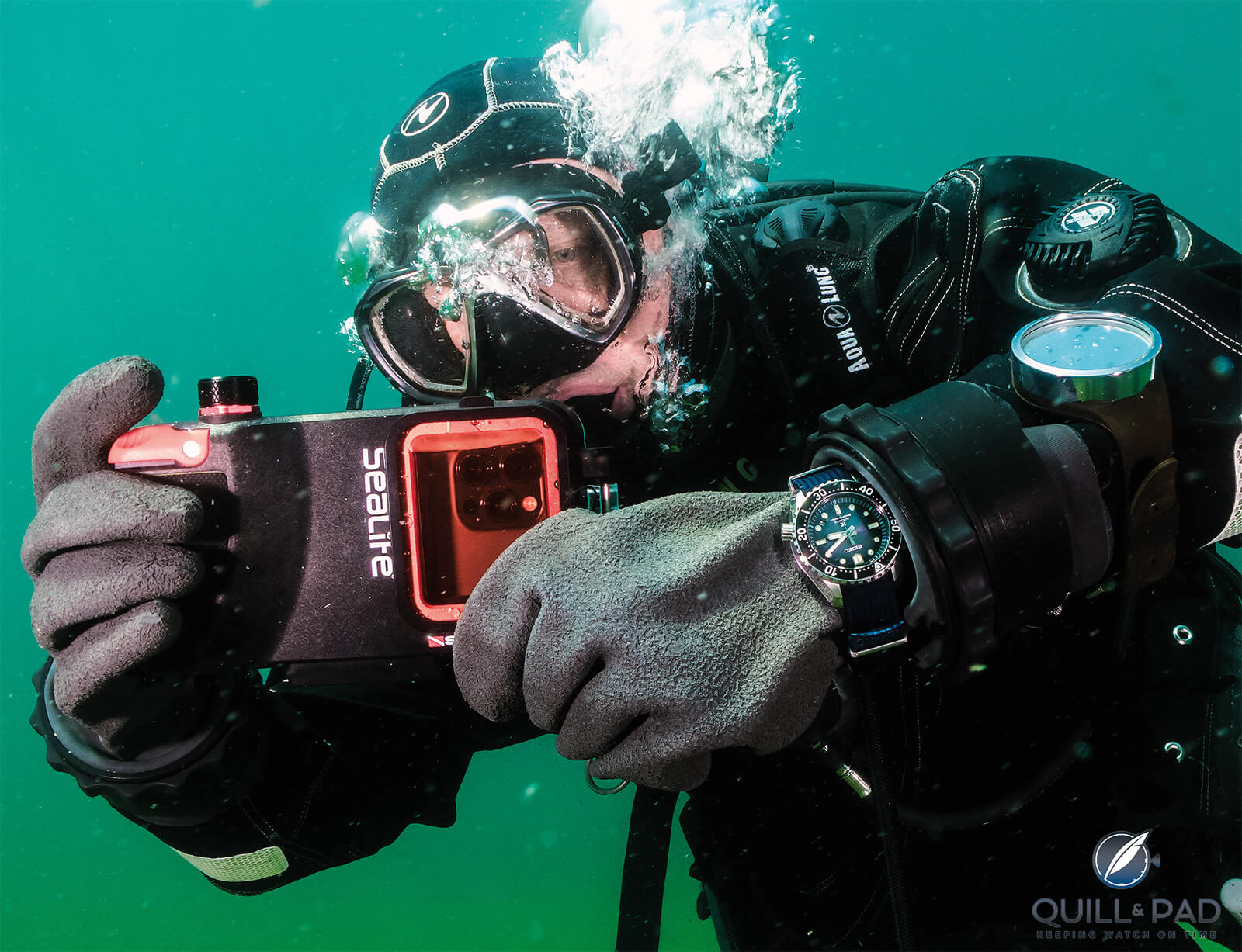
Seiko Prospex SLA055 on the wrist while diving (photo courtesy Dietmar Fuchs)
“A dive is like a long journey with a heavy load. Let your step be slow and steady, lest you stumble.”
This quote is loosely based on Tokukawa Ieyasu (1543-1616), Japan’s first shogun, and his alter ego Toranaga, protagonist of James Clavell’s imposing historical novel Shogun. A quote as if the Japanese “father of patience” had known how best to approach the underwater world since I replaced the word “life” with “dive.” Amazing outcome, isn’t it?
It’s just as amazing to take a look at one of the current watches in Japanese production. As a fan of the extraordinary Seiko Prospex 1000, I chose the limited version of the reinterpretation of a famous Seiko diving watch knowing that it is very likely that few other buyers of this watch will actually dive with it as I will.
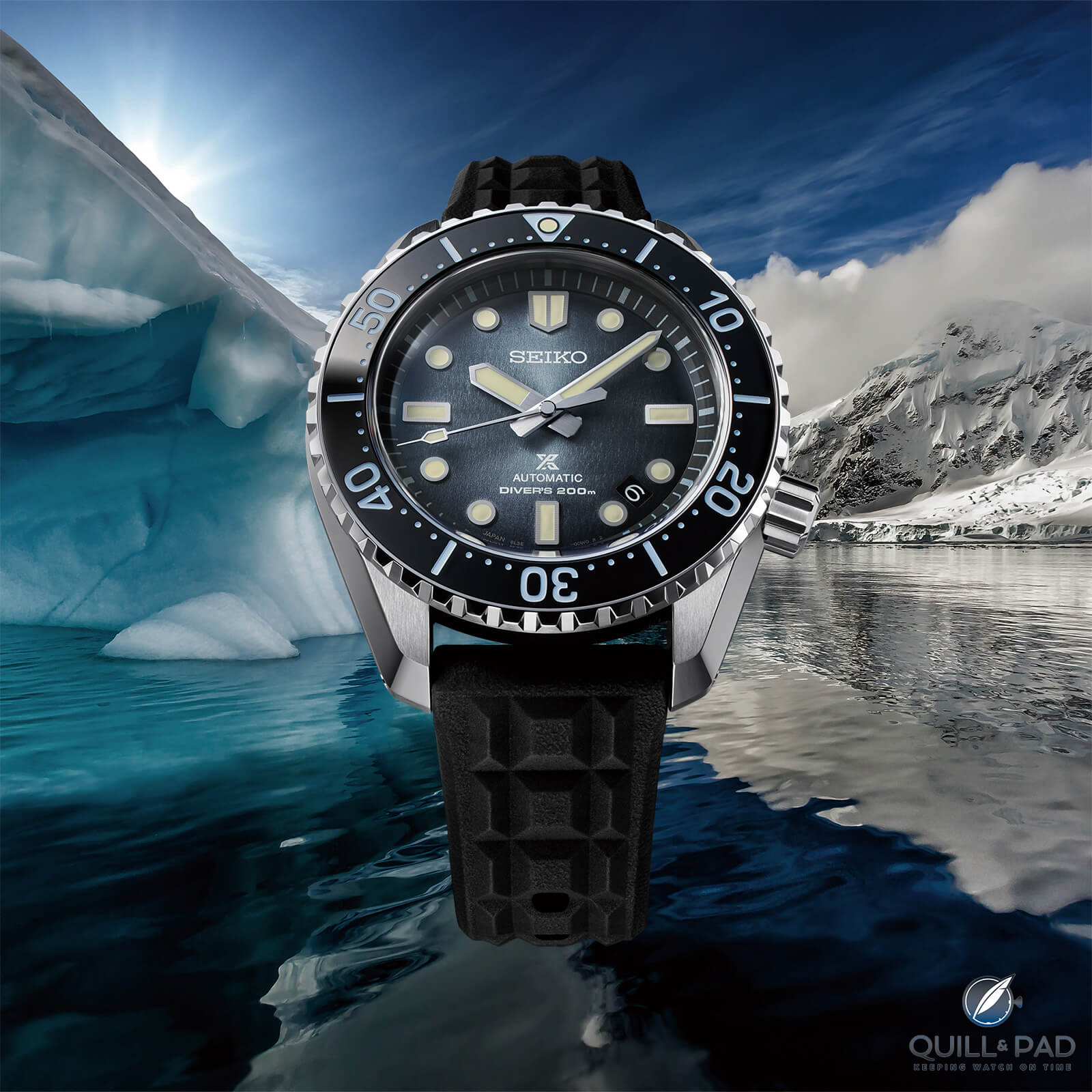
Seiko Prospex The 1968 Automatic Diver’s Modern Re-Interpretation Limited Edition SLA055
And with this choice I came across the first instance of common ground: the most valuable Japanese swords – just like watches – are those that stand up to all the hardships of everyday life and not those that languish idly in a showcase or watch winder.
Besides, I’m used to diving with expensive watches. And after taking the Prospex 1000 diving, I had no doubts that the SLA 055 would muster every challenge.
As I type these lines, I am again struck by the less than apt naming of Seiko timepieces. SLA055 – what is that supposed to tell us? I still haven’t figured it out and Seiko Germany couldn’t help me much either. In any case, SLA stands for the highest quality precision movement, but what the letters actually stand for is not known.

The second Japanese diving watch: Seiko Diver from 1968
The watch is a modern reinterpretation of the second Japanese diving watch from 1968. The first Japanese diving watch, also a Seiko, was launched in 1955, had its crown at the 3 o’clock position, and was tested at the time to 150 meters. For the second watch, Seiko moved the crown to the 4 o’clock position, making the watch more comfortable for everyday use and well protected against external shocks even without a clunky crown protector.
Steel and silk
Back to Japanese history and the Daitō: the Japanese sword, the katana. It’s no secret that steel is the secret to the katana’s incredible sharpness. And in the same way, it is a unique kind of steel that is responsible for the incredible shine of the SLA055 (terrible name, isn’t it?).
Seiko calls it “Ever Brilliant” and describes it, ” . . . Ever-Brilliant Steel, a grade of stainless steel that is more corrosion resistant than those commonly used in watches today . . . this material is widely used for the surfaces of marine structures and ships due to its extreme corrosion resistance in seawater. It has a PREN (Pitting Resistance Equivalent Number) value that is 1.7 times higher than that of the steel grade used in most high-end watches. PREN is a widely accepted standard for measuring corrosion resistance.”
I have never had any experience with rusting dive watches, and scratches have never bothered me either. Quite to the contrary.

Seiko Prospex The 1968 Automatic Diver’s Modern Re-Interpretation Limited Edition SLA055 in blue and black
The SLA – no, let’s call it the “katana watch” or, better yet and much more “Japanese,” “Daitō Tokei” – offers what I consider to be the most brilliant finish I’ve ever had the pleasure of admiring on a stainless steel watch. Of course, you can’t see that in the brochure or this article’s pictures; you can only see it when you wear the watch. I didn’t believe it myself until I was able to experience it. And it’s not only the extraordinary brilliance of the steel, it’s especially the unusual polishing technique used by the Japanese craftspeople. The mix of high-polished and matte surfaces . . . the contrast and play with light seems to dominate these watch cases like no other.
For me, it’s like moving the blade of a Daitō back and forth in the light; the watch masters similar reflections. And for the first time, I’m now bothered even by the tiny scratches that our test watch suffered during the hard daily diving routine.

Seiko Prospex SLA055 on the wrist while diving (photo courtesy Dietmar Fuchs)
And about the silk: the handle of a katana is artfully wrapped with a band, the Tsuka-Ito silk braid, which not only looks great but is also practical in that it prevents slipping. The watch also has a strap developed by Seiko craftsmen that is braided with the same weaving technique as the silk on the Daitō, called Seichu. As Seiko describes, “The textile bands use a traditional braiding technique from Japan called Seichu. Their rich texture and hue are well known in Japanese culture for their use in fabric designs. They can also be found in the traditional ‘obijime,’ the decorative cord that ‘holds’ a kimono sash in place” . . . or a sword in the hand of a kendoka or a Seiko on the wrist of a diver.
But it wasn’t the beauty alone that drew me to the strap of the “katana watch”: above all, it was the way it felt to wear. No other textile strap has achieved this to date. Unfortunately, though, after so much praise, it’s still not unreservedly practical for a diver.
What is the best strap?
At first glance, the strap is very long, which makes it ideal for wearing over a dry suit. But, as it turned out later, it was unfortunately still too short. Worn on dry land, however, the overlapping long strap disturbs a bit. Where to put it?
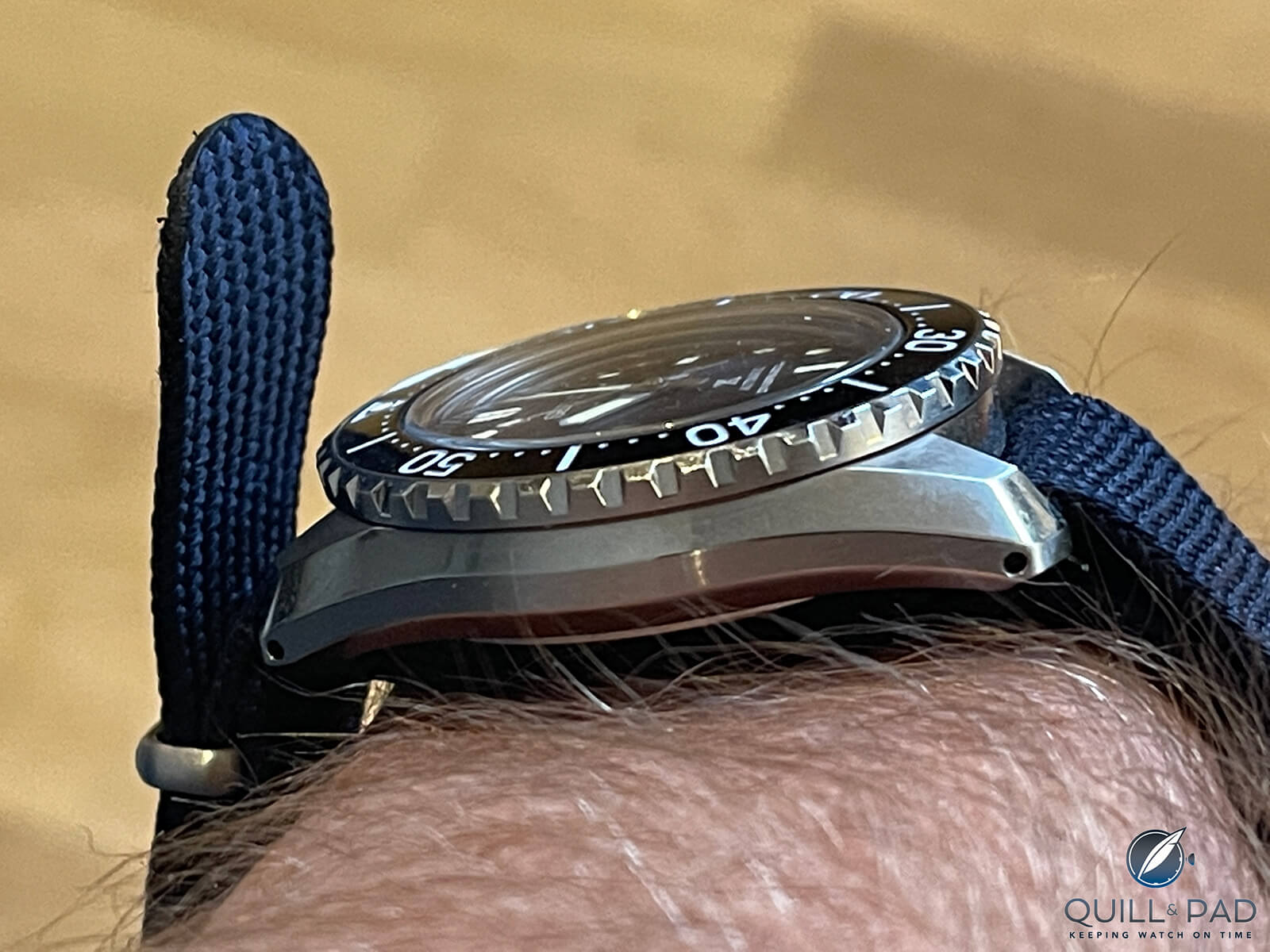
Seiko Prospex SLA055 on the wrist (photo courtesy Dietmar Fuchs)
This was a question that unfortunately Seiko could not answer, and I was left to my own devices before finding a very nice solution: I simply doubled the perforated part over and led the pin through both holes lying on top of each other and then put the doubled band through the first loop.
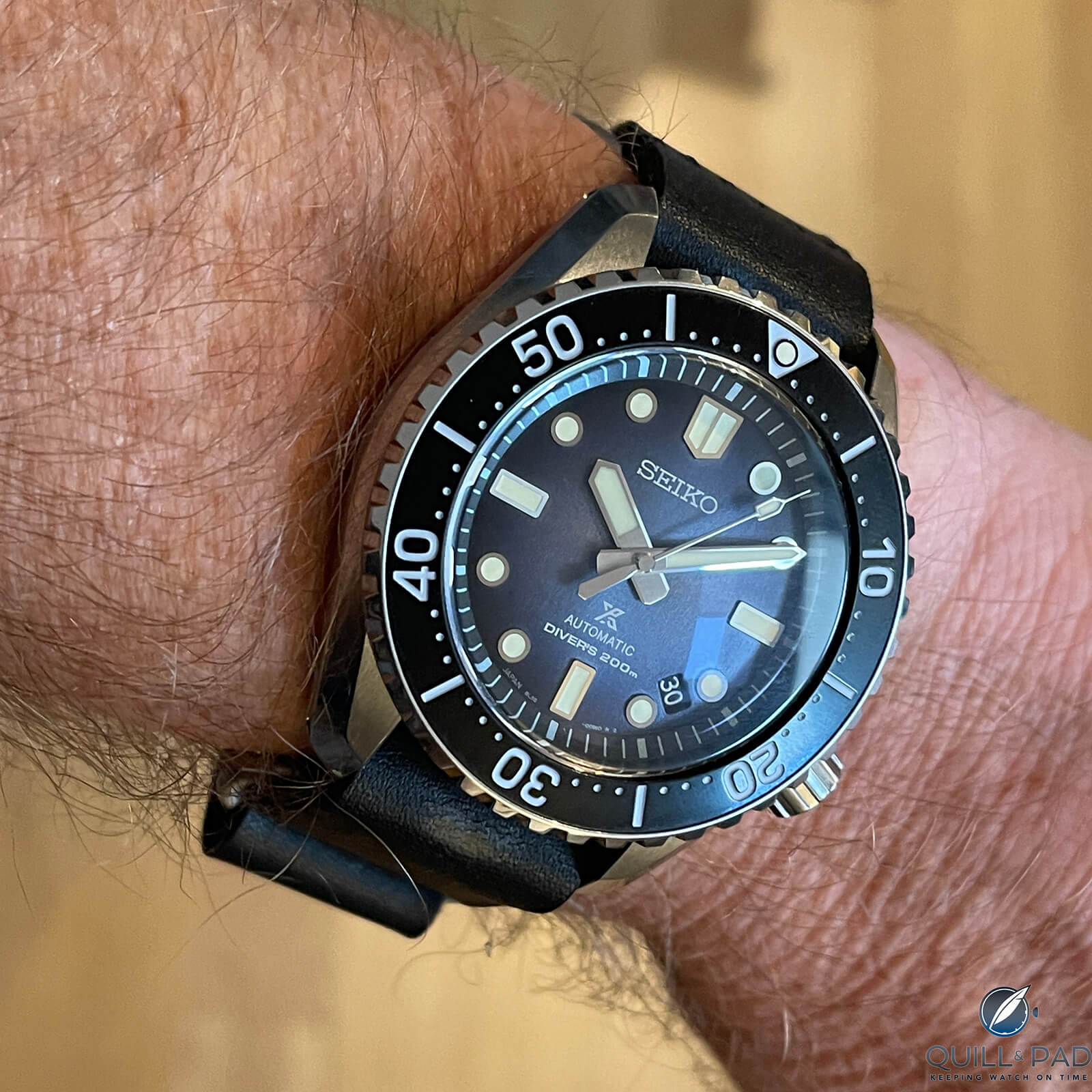
Seiko Prospex SLA055 on the wrist (photo courtesy Dietmar Fuchs)
This was a bit fiddly, but since I wear my watches day and night this was perhaps the most attractive solution for wearing this beautiful strap every day.
Dive experience
And while we’re at it, let’s get to the diving experience with the “Daitō Tokei.” As expected, the watch didn’t cause any problems at all underwater. Even in its rather compact size, it was perfectly readable and the dive time ring could be operated safely even with thick gloves. I will no longer bother criticizing the fact that only the 12 o’clock position on the ring is luminous during night dives since no one except Blancpain with the Fifty Fathoms has responded to this criticism to date.

Seiko Prospex SLA055 on the wrist while diving (photo courtesy Dietmar Fuchs)
So I come to my favorite assessment: the strap. Seiko has already done a lot of things right by making a very long textile strap that is more flexible than other textile straps due to the unique braiding technique. But then it has this unspeakable pin buckle. Why? This type of clasp cannot be easily loosened and retightened underwater. You always run the risk of losing the watch or living with it loosening and twisting as you descend or lashing it tightly in the depths as you surface, pinching your arm.
Regular readers will know what I recommend: the double D-ring from a motorcycle helmet. This can be quickly loosened but holds tight in a bombproof manner. And since in this case the much-too-long strap worn on the naked arm would dangle in an unsightly way, it can simply be folded back through the eyelets and then looks as elegant as the doubled Seiko strap – without any annoying fumbling.
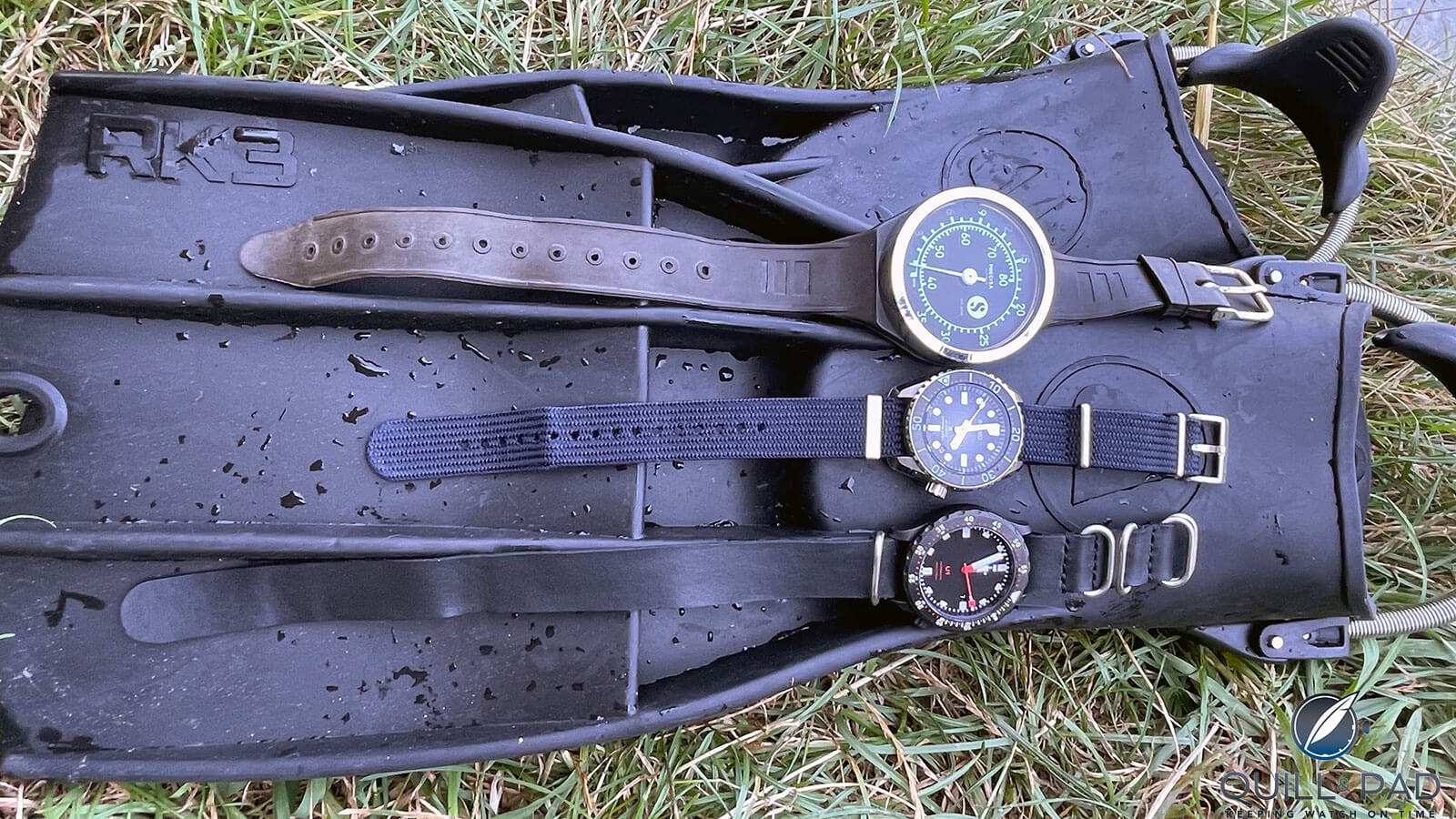
Seiko Prospex SLA055 ready to dive (photo courtesy Dietmar Fuchs)
About the movement
I normally don’t say much about the inside of the watch as it of no relevance for a diver, but because it’s the movement that (mostly) determines the price of a watch, I can’t just ignore it on a Seiko costing four and a half thousand Euros. The reason for such a high price tag: inside the watch ticks a variant of the Grand Seiko base movement 9S55, uncharitably called the 8L35, but still the highest Japanese craftsmanship in watch caliber construction and, like the 9S55, assembled in the Grand Seiko manufacture in Shizukushi Prefecture.
In the words of the manufacturer, “The watch is powered by Caliber 8L35, which was specially developed for diving watches and is assembled by hand by the craftsmen at the Shizukuishi Watch Studio in northern Japan. The movement’s robustness and precision ensure the best possible performance in the most demanding conditions, both on land and underwater.”
Which makes me curious as to whether the craftspeople test the watch right away in Gosho Lake, which is only a few hundred meters away?
Diving watch of the future?
I always regret it when a real dive test goes so smoothly. The high-quality diver’s watches in my test series are all tight and, as a rule, very easy to read. Neither the manufacturers nor the occasional divers seem to be interested in anything more. Maybe because most divers still wear computers on their wrists anyway, or – more recently – the unbeatably practical Garmin watch computers. Or perhaps soon the same type of thing from Apple/Oceanic (at the time of my Seiko test, the Oceanic software was not yet available).
Not so with me. During my leisure dives on compressed air (not deeper than 30 meters) I exclusively use one of my dive watches, a depth gauge, and the simple “90 rule” in my head. I therefore wish for nothing more than a visually attractive depth gauge to go with a beautiful diver’s watch like the “Daitō Tokei.”
90 rule: 90 minus two times the depth (in meters) = no decompression time. So a dive at 30 meters must be stopped after 30 minutes (90-2 x 30 = 30).
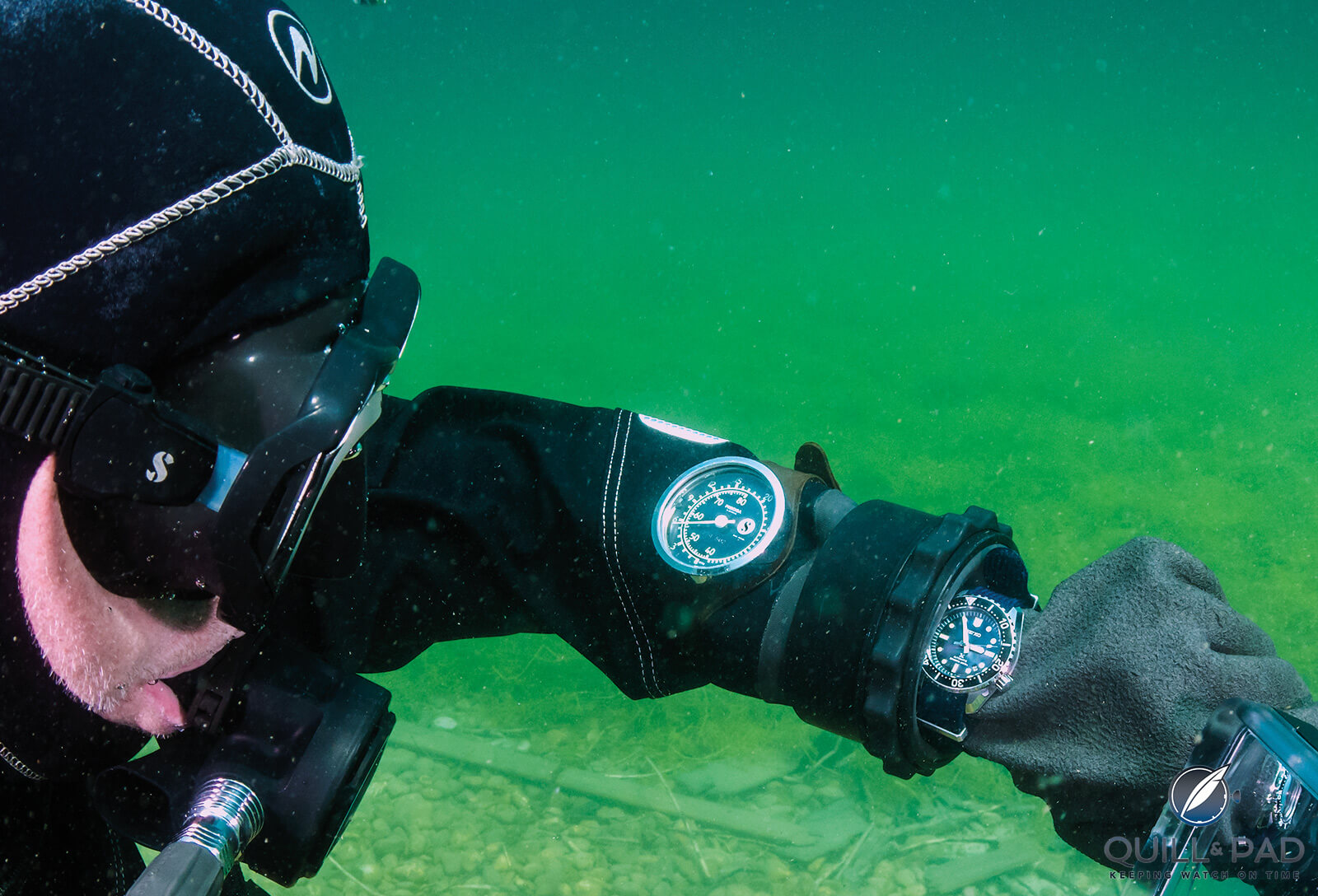
Seiko Prospex SLA055 on the wrist while diving with a depth gauge (photo courtesy Dietmar Fuchs)
Yes, I know that the depth gauge needs to be a bit bigger, but divers aren’t really fashion-conscious adventurers, either. Besides, the trend in diving watches has already reached 45 millimeters in diameter and more (which is almost too big for me) so why shouldn’t the matching membrane depth gauge be a bit bigger than the watch? Blancpain’s X Fathoms has led the way, but unfortunately this exceptional watch is also exceptionally expensive.
A depth gauge in the “Ever Brilliant” design of this “katana watch” would really please me, no matter if it costs triple that of a “normal” depth gauge. In this case I would love to offer my expertise to any watch manufacturer who is willing to experiment!
The first step toward the diving watch of the future might already be recognizable in the underwater photos shown in this article: The double S of Seiko and Scubapro? Let’s see what happens.
Conclusion
The Seiko Prospex The 1968 Automatic Diver’s Modern Re-interpretation Limited Edition (SLA055) is one great diving watch with one great strap, almost too good to be true, and definitely the perfect diving watch for a fan of Japanese history and lifestyle. A few tiny improvements around the strap and diving ring and even I would be 100 percent satisfied.
For more information on this watch, please visit seikowatches.com/us-en/products/prospex/special/1968-savetheocean.
Quick Facts Seiko Prospex The 1968 Automatic Diver’s Modern Re-interpretation Limited Edition (SLA055 and SLA057)
Case: 42.6 x 13.1 mm, Ever-Brilliant Steel, water resistant to 200 meters
Movement: automatic manufacture Caliber 8L35 with 50-hour power reserve, 28,800 vph/4 Hz frequency
Functions: hours, minutes, seconds; date
Limitation: 1,300 pieces
Price: $4,600
Remark: comes with silicone strap and an additional Seichu textile strap
You may also enjoy:
The Diving Bezel: The Most Versatile Watch ‘Complication,’ Even If You’re Not A Diver
A Comprehensive Look At Mechanical Depth Gauge Watches
Blancpain Fifty Fathoms: Story Of The World’s First Diving Watch (Video)
Diving With The Ball Watch Engineer Master II Diver Chronometer
Leave a Reply
Want to join the discussion?Feel free to contribute!



Cool focus on the underwater experience and what it’s like to operate the watch down below. To your point about the 12’o’clock lume pip, surely the Tudor Pelagos is your night diving saviour?? 🙂 How does this seiko stack up, in your opinion, to other high end divers you have tested?
Dear Tudor_addict,
wow, yes, thanks, that watch would make me happy (checked the “night version” out online), alas with my kind of bracelet, not the steel version.
I also like the possibility to get it with the crown on the 9 o’clock position (better for drysuit-diving!).
So I instantly listed “your” watch on my future “test” list.
If I could get Tudor to change their Nato-bracelets into “my” D-ring favorite, this could be an overall winner 🙂
Thanks again!
Dietmar »D«
Love Seiko diver’s watches I have the sbbn015 tuna very special watch, I have couple of Rolex in my collection but the 015 is my favourite proper diving tool 100%
Dear Matthew,
ah yes, great watch and in my eyes the best divers watch design ever, and the best case anyway. I bought the “grandfather tuna” in 1983 in Puerto Rico when I was still a diver – and sold it for a Rolex Sea Dweller before I started collecting watches. Bad mistake.
The Sea dweller had to make place for a Doxa that I still own and all diving watches thereafter.
Now I’m writing about diving watches more than diving them 🙁
I just finished an extensive article on Seiko’s »tuna« series and am waiting for the next new “anniversary tuna” to post it – maybe I shouldn’t wait?
You would love the story 🙂
Cheers Dietmar
There’s a lot of watches I would of purchased and watches that I would still purchase if they only had the day and date.
Dear Joe,
Day and date? For diving I need neither as I spend only hours in the water and only minutes in the deep. The bezel is all I need, a bright luminous dial and a proper watch band (the latter non existing).
But now, if I remember correctly, most of my diving watches have a small window with a number behind it that changes every day. I didn’t know what for but maybe that is the day? 😉
Joking aside, I understand and there are some diving watches with day/date. The above mentioned Seiko (sbbn015) for example! But then you are probably not looking for a tough diving watch but something more shining and sophisticated?
But isn’t it always fun to look for your next favorite watch?
Best regards
Dietmar